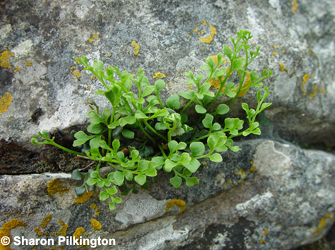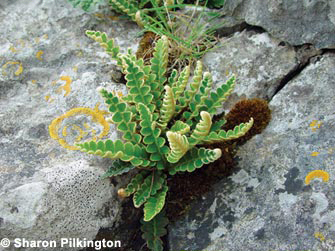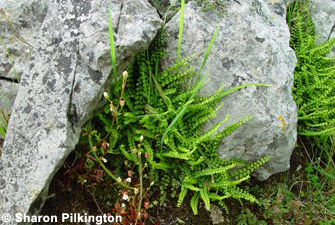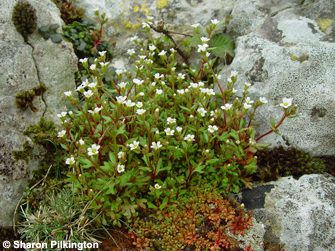
Special Mendip habitats
Introduction | Limestone cliffs, crags, caves and screes | Limestone heath | Old lead workings | Ash-lime woodland
Limestone cliffs, crags, caves and screes



Limestone cliffs, bluffs, outcrops, caves and screes are a distinctive feature of many Mendip nature reserves, especially Cheddar Gorge, Burrington Combe, Ebbor Gorge and Draycott Sleights. Such habitats present particular challenges; they are often sun-baked and wind-scoured, with small pockets of impoverished soil. Screes are unstable, nutrient-poor and dry. On Mendip, both habitats support very distinctive vegetation communities, which include a number of uncommon plants.
Limestone cliffs offer plants some protection from grazing animals and human attention. Whilst the now rare Cheddar pink was once widely distributed throughout Cheddar Gorge, today it is frequent only on high, inaccessible crags where it is relatively safe from collectors. This plant, like some others that are characteristic of cliff habitats on Mendip, needs open, sunny situations and cannot tolerate much competition from other plants. Other notable cliff-dwellers include slender bedstraw, lesser meadow-rue and spring cinquefoil and, in Cheddar Gorge, two endemic whitebeams.

Open, sunny screes tend to support vegetation that is dominated by lime-loving perennial species and open scrub. Many screes are home to limestone fern, a nationally scarce fern rare in southern England, and false oat-grass. Whilst these species need an open, sunny situation, many other plants found on screes are more commonly associated with woodlands. Herb Robert, wood sage, wall lettuce and dog's-mercury are all common. Mats of calcicolous (lime-loving) mosses play an important role in stabilising rock talus, and shady microclimates provided by larger rock fragments or crevices support a distinctive assemblage of small ferns, including maidenhair spleenwort, wall rue and rustyback.
Many natural caves have developed in the limestone bedrock, and their chambers, rifts and passages are a very important habitat for nationally rare greater and lesser horseshoe bats, especially during winter when they frequently hibernate underground, where the air temperature tends to remain stable.
- Home
- Overview maps
- Locality
areas
- Cheddar Gorge
- Charterhouse
- Blackdown
- Burrington Combe
- Shipham & Rowberrow
- Crook Peak & Axbridge
- Banwell to Churchill
- Priddy
- Harptree & Smitham Hill
- Draycott & Westbury-sub-Mendip
- Wookey Hole & Ebbor Gorge
- Wells
- Great Elm & Vallis Vale
- Mells & the Wadbury Valley
- The Vobster area
- The Whatley area
- Torr Works & Asham Wood
- Beacon Hill
- Stoke St Michael & Oakhill
- Holwell & Nunney
- Shepton Mallet & Maesbury
- Gurney Slade & Emborough
- The Nettlebridge valley
- Geology
- Minerals and mines
- Quarrying
- Caves and karst
- Biodiversity
- Detailed site information
- Acknowledgements
- External links
- Search
- Site map